For many years, digital marketers and SEO professionals have relied on a tried-and-true method to earn backlinks and improve search rankings: taking an already successful piece of content and making it even better. This approach has delivered impressive results, helping websites raise the search engine results pages (SERPs) and drive organic traffic. Yet, with Google's ever-evolving algorithms and more competition for quality backlinks, many wonder whether or not this method still works in 2026.
At first glance, the logic behind the skyscraper method remains sound. After all, search engines continue to prioritize authoritative, high-quality content, and link building is still a crucial ranking factor.
However, the landscape of digital marketing is not what it was a decade ago.
AI-generated content is dominating the web, search engines are getting better at detecting overoptimized tactics, and website owners are more cautious about who they link to. This raises an important question: Is the skyscraper technique still a viable way to dominate the SERPs, or has it lost its edge?
In this article, we'll examine the current state of this popular link-building method. We'll explore how it has evolved, the challenges it now faces, and whether it remains an effective tool in your SEO arsenal.
Whatever stage of experience you're in – from hands-on marketers to the fresh faces behind the curtain of link building – understanding the strengths and limitations of this technique in today's digital world can help you make more thoughtful content marketing decisions.
The Skyscraper Technique As a Game-Changer in SEO

What Is the Skyscraper Technique?
The world of SEO and content marketing is fiercely competitive. Every website fights for visibility, every brand strives for authority, and every marketer seeks the secret formula to rank higher on Google. In this battle for search dominance, one strategy has stood out for over a decade: the Skyscraper Technique.
The following passages will help you get to know what the skyscraper method is.
- Understanding the Skyscraper Technique:
The skyscraper technique is a white-hat link-building strategy that focuses on creating the best possible version of existing high-ranking content to earn more backlinks and improve search engine rankings. The idea is simple: find what works, make it even better, and get people to notice it.
The Core Principle: Build Taller
Just like a real skyscraper dominates a city skyline by being the tallest, this technique encourages marketers to create superior content that outshines competitors.
The process is outreach-based, meaning you actively contact website owners who have included links to similar content and persuade them to replace those links with yours. When done correctly, it can result in high-authority backlinks, better organic rankings, and increased traffic.
- How the Skyscraper Technique Works?
The skyscraper method is straightforward but requires effort. Here's a short guide on how you can implement it:
- Find Popular Content with High Backlink Potential
Start by identifying content that already ranks well and has tons of backlinks. You can use tools like:
- Ahrefs: to analyze backlinks and content performance.
- Semrush: for keyword research and competitor analysis.
- Google Search: to see what's ranking at the top for your target keywords.
Look for articles with many links and cover topics that are still relevant today.
- Create Something Better
Now comes the fun part–leveling up the existing content. Here's how:
- Make it More Comprehensive. Add in-depth research, case studies, or expert opinions.
- Update the Data. Use fresh statistics and studies to ensure accuracy.
- Enhance the Visuals. Infographics, videos, and images make content more engaging.
- Improve Readability. Break up long paragraphs, use bullet points, and make it scannable.
Ask yourself: What would you expect to see if someone was looking for the best article on this topic?
- Promote Your Content and Build Backlinks
Great content means nothing if nobody sees it. This is where outreach comes in.
- Find the Right People: Use SEO tools to identify websites linking to the original content.
- Send Personalized Outreach Emails: Contact webmasters, bloggers, and journalists with a compelling reason to link to your content instead.
- Leverage Social Media: Share your article in relevant communities and groups.
- Engage with Influencers: Ask industry experts to share your content.
Outreach is key to making the skyscraper technique work, so don't skip this step!
- The Origin of the Skyscraper Technique:
Brian Dean introduced the skyscraper technique in 2013 to simplify and improve link building. His method proved so effective that his website's organic traffic increased by 110% within two weeks.
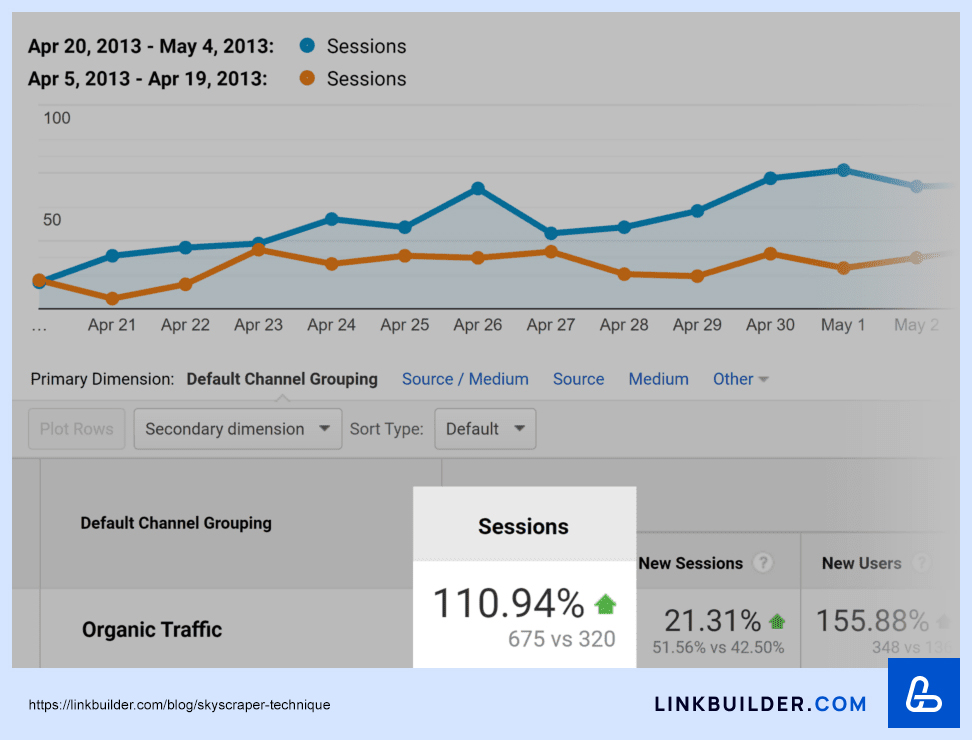
Brian's first attempt involved sending 160 outreach emails, which led to 17 high-quality backlinks. It’s an impressive success rate compared to the average conversion rate for cold outreach! Since then, SEO professionals worldwide have adopted and modified the skyscraper technique to fit modern search algorithms.
- Why Is It Called the Skyscraper Technique?
Think about the tallest building in a city. It naturally attracts attention because it towers over everything else. The same principle applies to content. If you create something bigger, better, and more valuable than the existing top-ranking content, you have a higher chance of getting noticed, shared, and linked to.
In short, the skyscraper technique is what helps your content stand out in the SERPs, like a landmark in a crowded skyline.
The Role of the Skyscraper Technique in SEO
The skyscraper technique has played a transformative role in modern SEO, influencing how content is created, optimized, and promoted for maximum visibility. With its emphasis on high-quality content and strategic link building, this approach has become a key factor in improving search rankings and driving organic traffic.
The impact of skyscraping in SEO extends beyond individual articles, shaping the broader SEO landscape by encouraging competitive analysis, ethical outreach, and superior content experiences.
To better understand the role of the sky scraper method, let’s break it down into key areas where this strategy has had a lasting influence:
Shaping Modern SEO Strategies:
The skyscraper technique has significantly reshaped how digital marketers approach search engine optimization. By focusing on outperforming existing content, it aligns with Google’s evolving algorithms that prioritize high-quality, authoritative, and user-friendly content. This method has influenced how businesses structure their content marketing strategies, emphasizing the importance of competitive research and continuous content improvement.
Establishing Content as a Ranking Driver:
The skyscraper technique has strengthened the notion that one of the most important elements influencing search rankings is the quality of the content. Search engines increasingly favor comprehensive, well-structured, and informative content. By encouraging content creators to analyze and improve upon existing top-ranking pages, the technique has contributed to the widespread adoption of detailed, in-depth content across various industries.
Supporting Search Engine Algorithm Updates:
Google’s algorithm updates, such as those targeting low-quality content and spammy link-building tactics, have made the skyscraper technique even more relevant. This method aligns with Google’s focus on E-E-A-T (Experience, Expertise, Authoritativeness, and Trustworthiness) by ensuring that only well-researched, highly informative content earns backlinks and rankings. As a result, it has helped websites stay competitive in an ever-changing SEO landscape.
Reinforcing the Importance of Competitive Analysis:
The skyscraper technique has contributed to the growing emphasis on competitor analysis in SEO. Marketers and businesses now routinely examine the strengths and weaknesses of high-ranking pages to determine how they can create superior content. As a result, SEO strategies have changed, with data-driven decision-making becoming increasingly crucial for content development and optimization.
Reshaping Outreach and Digital PR Efforts:
Traditional SEO outreach strategies typically involved mass email campaigns with generic pitches, leading to low response rates. The skyscraper technique has introduced a more personalized and strategic approach to outreach. By targeting web admins who have already demonstrated interest in linking to similar content, the process has become more refined, fostering higher engagement and relationship-building within the industry.
Aligning Content Marketing with User Intent:
The skyscraper technique has reinforced the need to align content with user intent. By analyzing existing top-ranking pages, content creators gain valuable insights into what users seek. This understanding helps craft content that meets and exceeds user expectations, leading to better search visibility and audience engagement.
Adapting to New SEO Technologies and Trends:
As SEO evolves, so does the skyscraper technique. The rise of AI-powered content analysis tools, automated outreach systems, and advanced keyword research methods has allowed marketers to refine and optimize this strategy further. The technique’s adaptability has ensured its continued relevance in an era of constantly changing search engine algorithms and user expectations.
Enhancing the Relationship Between Content and Backlinks:
The skyscraper technique has reinforced the direct connection between high-quality content and backlink acquisition. By proving that well-structured, valuable content naturally attracts links, skyscraping has influenced SEO professionals to move away from artificial link-building schemes and instead focus on creating link-worthy resources.
Encouraging a More Ethical Approach to SEO:
With search engines cracking down on manipulative tactics, the skyscraper technique has helped shape a more ethical SEO landscape. By prioritizing quality rather than quantity in both content and link-building practices, this focus has fueled the industry's shift toward more transparent and user-centered approaches that comply with the guidelines of search engines like Google.
Influencing Content-Length and Depth in SEO Best Practices:
Before the skyscraper technique gained popularity, many content strategies focused on short, surface-level articles. However, the method has encouraged a shift toward in-depth, long-form content that provides comprehensive insights into a topic. This has had a lasting impact on SEO best practices, where longer, well-researched articles now have a higher chance of getting top positions in search results.
Strengthening the Connection Between SEO and Branding:
The skyscraper technique has shown that ranking well in search results is not just about optimizing for algorithms – it’s also about establishing brand authority. Websites that consistently create superior content gain a reputation for being thought leaders in their industry. This connection between SEO and branding has influenced how companies approach content marketing.
Contributing to the Growth of Digital Content Marketing:
As the skyscraper technique is recognized in SEO, this method has helped to grow the digital content marketing arena as a key area of business growth strategy. With a clear focus on high-quality content, the skyscraper SEO technique has led to increased investments in content creation, SEO tools, and teams dedicated to producing industry-leading skyscraper articles.
Demonstrating the Power of Data-Driven SEO:
The skyscraper technique uses search data to identify high-ranking content and backlink sources, reinforcing the importance of data-driven decision-making in SEO. Marketers now rely more heavily on analytics, competitor research, and performance tracking to refine their content strategies and improve search rankings.
What Are the Benefits of the Skyscraper Technique?

The skyscraper method's core principle is creating superior content that outperforms existing top-ranking articles. It helps websites gain visibility, attract high-quality backlinks, and strengthen their online presence. While the method requires time and effort, the benefits it offers can have a lasting impact on a website's search engine performance and brand authority.
Below, we explore the primary benefits of the skyscraper technique. Read and see why it remains a powerful strategy for improving search rankings, driving organic traffic, and establishing credibility in any industry.
- Higher Link Acquisition
One of the primary benefits of the skyscraper technique is its ability to attract high-quality backlinks.
When content is optimized to provide more value than existing articles, other websites are more likely to reference and link to it. It's because site owners, bloggers, and content managers naturally prefer linking to the best, most up-to-date resources in their niche.
By strategically reaching out to those who have already linked to similar content, the skyscraper technique increases the chances of earning authoritative backlinks, improving overall SEO.
- Increased Domain Authority
A strong backlink profile is one of the most critical factors in search engine rankings. Search engines like Google evaluate backlinks as endorsements, indicating the website's trustworthiness and credibility.
By implementing the skyscraper technique, businesses can earn links from reputable websites, boosting their domain authority over time. Higher domain authority leads to better search visibility, making ranking for competitive keywords and attracting organic traffic easier.
- Long-Term SEO Gains
Unlike short-term SEO tactics that may provide quick but temporary results, the skyscraper technique offers long-lasting benefits.
Well-optimized skyscraper content remains relevant and valuable over time, continuously attracting backlinks and maintaining high rankings. This type of content is often evergreen, covering topics that remain useful to readers for months or even years, driving traffic and engagement long after its initial publication.
- Improved Brand Authority
The skyscraper technique not only enhances SEO but also strengthens brand credibility. When a website consistently publishes superior content that outperforms competitors, it positions itself as an industry leader. Readers and professionals begin to recognize the brand as a go-to source for valuable information.
Increased trust and authority lead to more opportunities, such as guest posting, partnerships, and media mentions, further expanding the brand's influence within its niche.
- Better Content Performance
High-quality content created using the skyscraper technique tends to perform better regarding user engagement metrics. When articles are more comprehensive, well-structured, and visually appealing, visitors are likelier to stay on the page longer, increasing dwell time.
Additionally, well-researched content that provides in-depth insights helps lower bounce rates, as users get the information they are looking for without returning to the search results. Search engines receive positive signals from these engagement metrics, which cause further improved rankings.
- Greater Organic Traffic Growth
Since the skyscraper technique helps improve search rankings, it naturally leads to higher organic traffic.
When a webpage pops up within the top search listings for competitive keywords, it receives more visibility and attracts a larger audience. Unlike paid advertising, which requires ongoing investment, organic traffic generated through effective SEO strategies such as the skyscraper technique is cost-effective and sustainable.
- Enhanced Content Quality Across the Industry
As more businesses adopt the skyscraper technique, the overall quality of online content improves. This method encourages content creators to go beyond what already exists because readers benefit from more informative, well-researched, and engaging articles. It results in a better user experience, highlighting how crucial top-notch content is to digital marketing.
- Increased Social Shares and Engagement
Sharing on social media sites is more common for valuable and better-structured content.
The skyscraper technique encourages the integration of shareable elements like infographics, data visualizations, and actionable insights into the content so that users can share it easily. As a result, skyscraper content often enjoys higher engagement rates, expanding its reach beyond search engines.
- Competitive Advantage in Search Rankings
Since SEO is a highly competitive field, it takes more than just basic optimization to rank on the first page of search results. The skyscraper technique gives websites an edge by ensuring their content is significantly better than what is already ranking.
By continuously improving content and acquiring high-quality backlinks, businesses can continue to outperform their competitors and maintain their positions in the search results.
- More Effective Outreach Efforts
Traditional link-building outreach can be challenging, as webmasters receive numerous requests for backlinks every day.
However, the skyscraper technique makes outreach and link building more effective by providing a strong reason for website owners to link to the content. Since the content is objectively better than what they previously linked to, there is a higher likelihood of securing backlinks, resulting in more successful outreach campaigns.
- Alignment with Google's Algorithm Updates
Google's search algorithms continue to evolve, strongly focusing on rewarding high-quality, user-friendly content.
The skyscraper technique aligns well with these updates, encouraging in-depth research, better structuring, and more engaging content experiences.
Websites that use this method are less likely to be negatively impacted by algorithm changes, as their content remains valuable and relevant.
- A Scalable and Repeatable SEO Strategy
One of the reasons the skyscraper technique is so popular is that it is highly scalable. Once a business successfully applies this method to content, it can replicate the process across multiple topics and keywords. It allows for continuous growth in search rankings, traffic, and brand visibility over time.
The skyscraper technique provides numerous benefits that extend beyond just rankings and backlinks. From building long-term authority and trust to improving user experience and engagement, this approach continues to help businesses and content creators achieve lasting success.
By focusing on quality, strategic outreach, and continuous improvement, websites can maximize the benefits of this method and strengthen their position in an increasingly competitive digital landscape.
The Evolution of Content Marketing and SEO in 2026

Major SEO Trends That Changed Content Strategy
Several major SEO trends have significantly influenced content strategy, pushing businesses and creators to adapt to new ranking factors and audience expectations. Understanding these trends is crucial for outperforming rivals in the competitive SEO world.
- AI-Powered Content & The Rise of Programmatic SEO
The prompt development of artificial intelligence (AI) has transformed SEO and content marketing. AI-powered solutions may now automate various aspects of content creation, including keyword research, writing, and optimization.
- Automated Content Generation: AI-driven writing assistants like ChatGPT, Google's Gemini, and more have enabled marketers to generate high-quality content more efficiently. These tools help scale content production while maintaining relevance and coherence.
- Smarter Keyword Research: AI-powered SEO platforms analyze search trends, user intent, and competition to suggest the best keywords for ranking opportunities. It allows businesses to target more relevant search queries with precision.
- Programmatic SEO: This technique involves using AI and automation to create thousands of landing pages tailored to specific search queries. Large-scale platforms, such as travel and e-commerce websites, leverage programmatic SEO to dynamically generate optimized content, ensuring that users find the most relevant pages instantly.
While AI has made content creation more efficient, Google still values human expertise and originality. AI-generated content must be well-structured, fact-checked, and tailored to user needs to maintain credibility and ranking potential.
- Topical Authority & Cluster-Based Content Strategies
Gone are the days when a single, high-ranking skyscraper post could dominate search results. Google now prioritizes topical authority, where websites are rewarded for demonstrating expertise in a specific subject area through interconnected content clusters.
- Content Hubs & Pillar Pages: Instead of standalone articles, successful websites now use content hubs that connect multiple related posts under a broader pillar page. For example, a website about fitness might have a pillar page on "Weight Loss Strategies" with supporting articles on diet plans, workout routines, and calorie counting.
- Semantic SEO & Search Intent: Google has improved its understanding of context and intent rather than just matching keywords. Websites that build content clusters around semantic relationships tend to perform better as they provide more comprehensive coverage of a topic.
- Internal Linking Strategies: Effective internal linking between related content helps search engines understand site structure while improving user navigation. It boosts engagement, time on site, and overall rankings.
To succeed in this new era of SEO, content creators must shift from writing isolated articles to developing well-connected, authoritative resources that align with Google's evolving ranking criteria.
- The Shift from Link-Building to Brand-Building
For years, backlinks were considered the ultimate ranking factor. While they still play an essential role, brand recognition and authority have become equally important for SEO success.
- E-E-A-T (Experience, Expertise, Authoritativeness, Trustworthiness): Google's emphasis on E-E-A-T means that websites must establish themselves as credible sources of information. Strong branding, expert authorship, and high-quality content contribute to this metric.
- Unlinked Brand Mentions: Google now recognizes brand mentions even if they don't include a direct backlink. A company frequently cited in news articles, blogs, and social media will see SEO skyscraper benefits even without traditional link-building efforts.
- Building Key Opinion Leader Image: Publishing original research, industry insights, and expert opinions helps establish a brand as a trusted authority. Businesses focusing on key opinion leadership attract organic mentions, partnerships, and referral traffic, indirectly enhancing search rankings.
- Social Signals & Online Presence: While Google does not officially count social media signals as a ranking factor, active engagement on platforms like X (formerly Twitter), LinkedIn, YouTube, and even Instagram or TikTok helps amplify content reach, driving more search visibility and organic backlinks.
This shift underscores the importance of holistic digital marketing. Instead of chasing backlinks solely through outreach, businesses should focus on building brand reputation and creating genuinely valuable content that people want to share and reference.
- User Experience (UX) as a Core SEO Ranking Factor
SEO is no longer just about pleasing algorithms; it's about creating an optimal user experience. Google now considers various UX factors when ranking pages, making usability a critical element of content strategy.
- Core Web Vitals: Google's Core Web Vitals focus on page speed, interactivity, and visual stability. Websites that load slowly or have unstable elements (like shifting content) risk losing rankings.
- Mobile Optimization: With Google's mobile-first indexing, websites must ensure their content is completely optimized for mobile users. Poor mobile experiences can result in higher bounce rates and lower rankings.
- Engagement Metrics: Google evaluates dwell time, bounce rates, and pages per session to determine content quality. Pages that keep users engaged signal relevance and are rewarded with higher rankings.
- Structured Content & Readability: Proper headings, bullet points, and concise paragraphs enhance readability, increasing content accessibility for both people and search engines.
- Multimedia Integration: Incorporating videos, infographics, and interactive elements enriches content, keeping visitors engaged for longer and increasing shareability.
How These Trends Have Changed Content Strategy?
The evolution of SEO has transformed content strategy in significant ways. Marketers and content creators must now approach SEO with a broader perspective, balancing technical optimization with user-centric, brand-driven approaches. Some of the most significant changes include:
- From Single Keyword Targeting to Topic Clusters. Instead of optimizing for one keyword per page, content strategies now focus on comprehensive topic coverage with interlinked articles.
- From Link Quantity to Brand Authority. Backlinks are still valuable, but establishing brand credibility and recognition is now just as important.
- From Short-Term Tactics to Long-Term Value. SEO success requires consistent, high-quality content creation rather than relying on quick fixes.
- From Algorithm Manipulation to User Experience Optimization. Google's ranking factors now prioritize real user engagement, forcing websites to focus on performance, accessibility, and interactivity.
As these trends continue to shape the digital landscape, businesses should remain flexible and adaptable in their content strategies. The future of SEO lies in creating truly valuable, user-focused content that complements search engine objectives while enhancing the overall user experience.
By embracing AI-driven insights, topical authority, brand-building efforts, and UX improvements, content creators can stand out in the ever-evolving world of SEO.
Google Algorithm Updates That Impact the Skyscraper Technique
Google’s search algorithms have evolved significantly over the years, reshaping how content is ranked and how backlinks influence SEO success. While the Skyscraper Technique has been a popular method for improving search rankings by creating superior content and acquiring high-quality backlinks, recent algorithm updates have introduced new challenges and opportunities for this strategy.
From Google’s Core Updates to the rise of AI-driven ranking factors, several changes have altered how search engines evaluate content quality, backlinks, and user experience. Understanding these shifts is essential for adapting the Skyscraper Technique to the modern SEO landscape.
- How Google’s Core Updates Affect Backlinking & Long-Form Content
Google frequently rolls out Core Algorithm Updates, each of which refines how search results are ranked based on relevance, authority, and user experience. These updates have had a direct impact on the effectiveness of the Skyscraper Technique, especially in the following ways:
Backlinks Alone Aren’t Enough. In the past, having more backlinks than competitors typically led to better search engine rankings. However, recent updates have shifted this focus, prioritizing the quality of links over quantity. Now, even if an article has hundreds of backlinks, they must come from relevant and authoritative sources to be effective.
Content Depth & Value Matter More. While the Skyscraper Technique encourages creating longer, more comprehensive content, Google’s updates have emphasized value over word count. Bloated, keyword-stuffed articles no longer rank as well as concise, user-friendly content that directly addresses search intent.
SERP Volatility & Competitor Adjustments. Google’s updates often cause ranking changes, meaning that even highly optimized skyscraper content can lose visibility overnight if Google re-evaluates ranking signals. It has made content maintenance and frequent updates crucial for sustaining rankings.
As a result, SEOs and content marketers using the Skyscraper Technique must focus on link-building and ongoing content optimization, user engagement, and trust-building to remain competitive.
- The Role of E-E-A-T (Experience, Expertise, Authoritativeness, Trustworthiness)
Google’s E-E-A-T framework (Experience, Expertise, Authoritativeness, and Trustworthiness) has significantly impacted content rankings, particularly in industries like finance, health, and law (YMYL–Your Money, Your Life topics). The Skyscraper Technique must now align with these quality standards to remain effective.
Experience & Expertise: Google increasingly values content written by subject-matter experts. It means that skyscraper content must be well-researched and showcase real-world experience through expert quotes, case studies, and firsthand insights.
Authoritativeness: Google favors content published by recognized industry leaders. Articles with solid author profiles, credentials, and external mentions tend to perform better. This means that merely improving on existing content is not enough – the author’s reputation and credibility matter.
Trustworthiness: Google penalizes misleading, low-quality, or unverified content. Skyscraper articles must be backed by credible sources, updated statistics, and accurate citations toVicarious content, requiring users to be more creative and engaging, enhancing user experience and SEO performance.
For Skyscraper content to succeed in an E-E-A-T-driven SEO landscape, it must go beyond surface-level improvements and establish genuine credibility and authority in its niche.
- AI & Machine Learning: Google’s New Ranking Metrics
Google’s increasing reliance on AI and machine learning has significantly influenced how content is ranked. Algorithms like RankBrain, BERT, and MUM have made Google more proficient at understanding search intent, user behavior, and content quality, changing how skyscraper-style content is evaluated.
Semantic Search & Natural Language Processing: Google now prioritizes content that aligns with search intent rather than just containing keywords. Skyscraper articles must be optimized for natural, conversational queries, making them more useful for voice search and AI-powered search tools.
Engagement Metrics Influence Rankings: AI-driven algorithms assess user engagement through metrics like click-through rates (CTR), dwell time, and bounce rates. If skyscraper content fails to keep users engaged, Google may push it down in rankings, even if it has strong backlinks.
Personalization & Context Awareness: Google’s AI models tailor search results based on user history, location, and browsing behavior. Even the most well-optimized skyscraper content might not rank consistently across various users and devices.
To adapt, skyscraper content must be structured for readability, optimized for engagement, and aligned with user intent rather than simply focusing on length and keyword density.
- The Decline of Traditional Link-Building and the Rise of Digital PR
While the skyscraper method for SEO growth relies heavily on outreach-based link building, Google’s algorithm updates have decreased the impact of traditional link-building tactics while increasing the importance of brand authority and digital PR.
Google Devalues Low-Quality & Manipulative Links. Algorithm updates have cracked down on guest posting abuse, link farms, and artificial link acquisition tactics. Skyscraper outreach efforts must now target highly relevant, natural link opportunities rather than focusing purely on volume.
Unlinked Brand Mentions Matter More. Google’s algorithms are getting better at recognizing brand mentions without explicit backlinks. Therefore, key opinion leadership, media coverage, and social proof play a more significant role in SEO rankings than ever before.
Content Amplification Through Digital PR. Instead of just reaching out for backlinks, marketers must proactively promote skyscraper content through industry publications, influencer collaborations, and PR campaigns to build authority and organic visibility.
Who knows how long traditional link-building will continue to provide effective results? Therefore, skyscraper-style content must be supported by strong brand-building efforts and multi-channel content distribution to maximize its SEO impact.
How to Apply the Skyscraper Technique Effectively in 2026

The Skyscraper Technique thrives on one fundamental principle: outperforming existing high-ranking content. But before creating something better, you should first identify what content to outrank. It includes understanding what’s already working, analyzing competitor strategies, and choosing topics that offer the best long-term value.
To do this effectively, you’ll need the right tools for competitor research and a clear strategy for selecting between evergreen and trending topics.
- Tools for Analyzing Competitor Content
To outrank competitors, you should analyze their content performance and understand why they rank well. SEO tools like Ahrefs, Semrush, and Moz provide valuable insights into:
- Top-performing content: Identify which pages rank highest for your target keywords.
- Backlink profiles: Find out how many backlinks competitors have and where they come from.
- Keyword difficulty & traffic potential: Understand which keywords drive the most traffic and whether they are realistic to target.
- Content gaps & improvement opportunities: Spot weaknesses in competitor content that you can capitalize on.
Ahrefs
Ahrefs is one of the comprehensive SEO tools for analyzing competitor content. You can use it to:
- Explore top-ranking pages using the Top Pages tool.
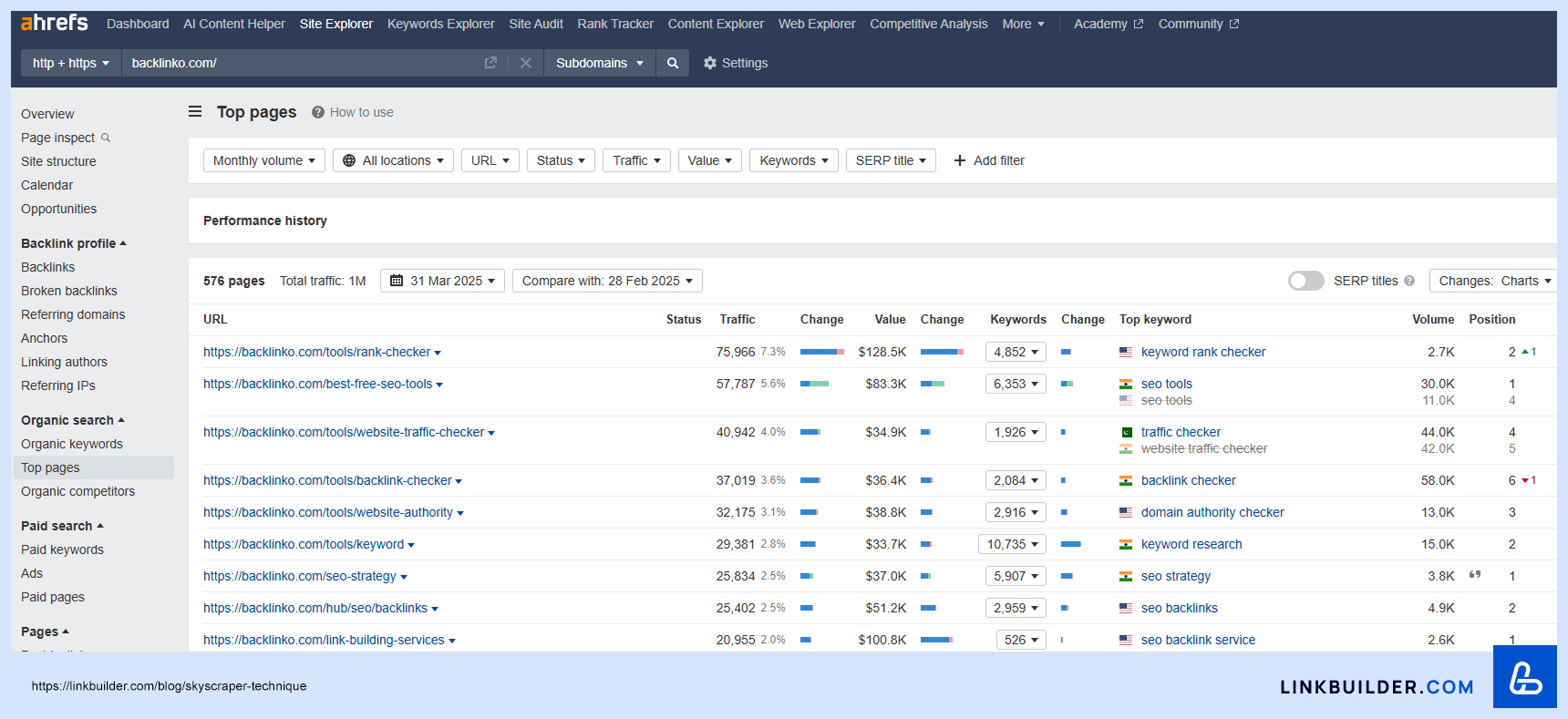
- Check backlink data to see who links to your competitors.
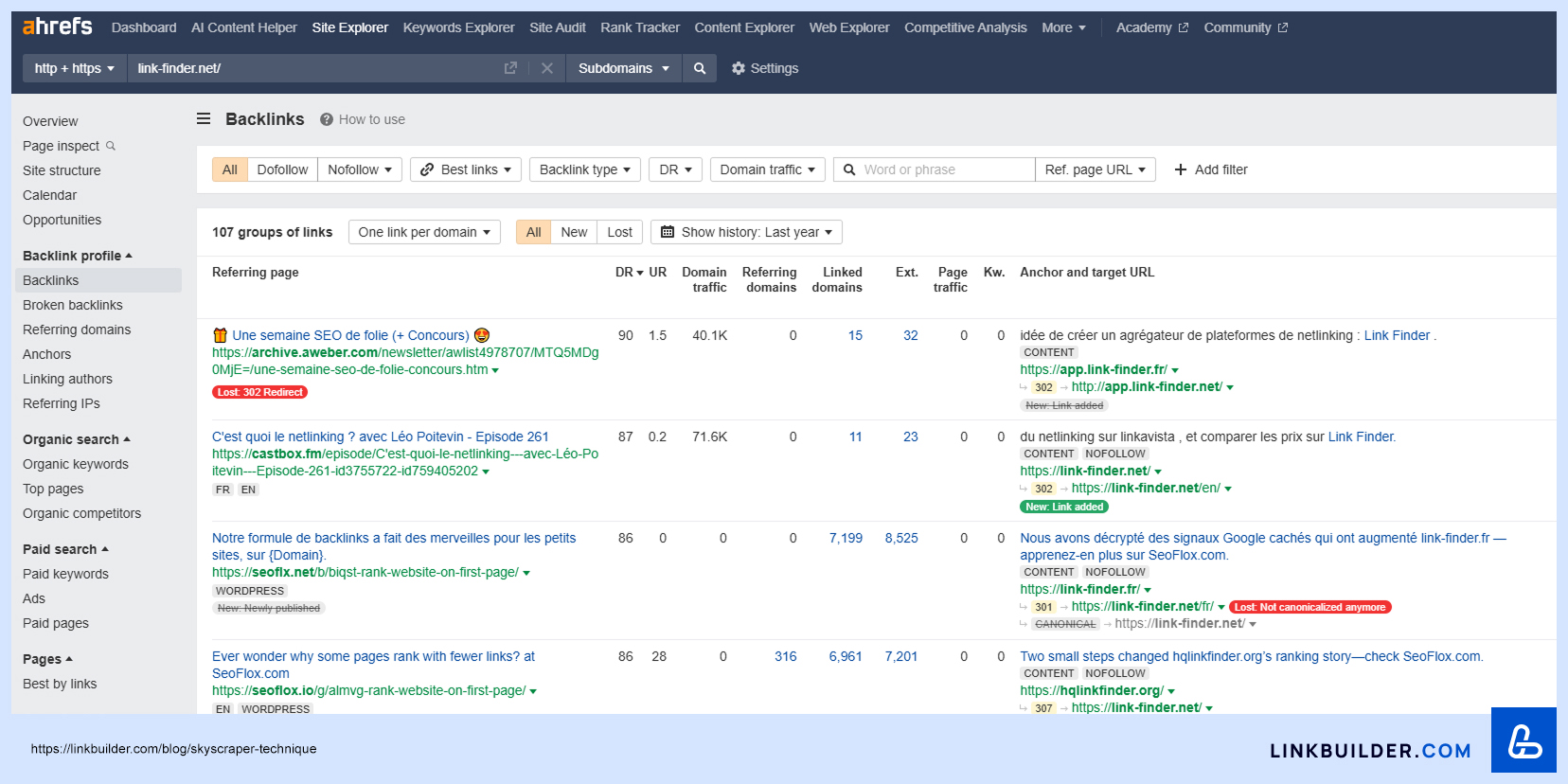
- Find keyword opportunities with the Organic Keywords tool.
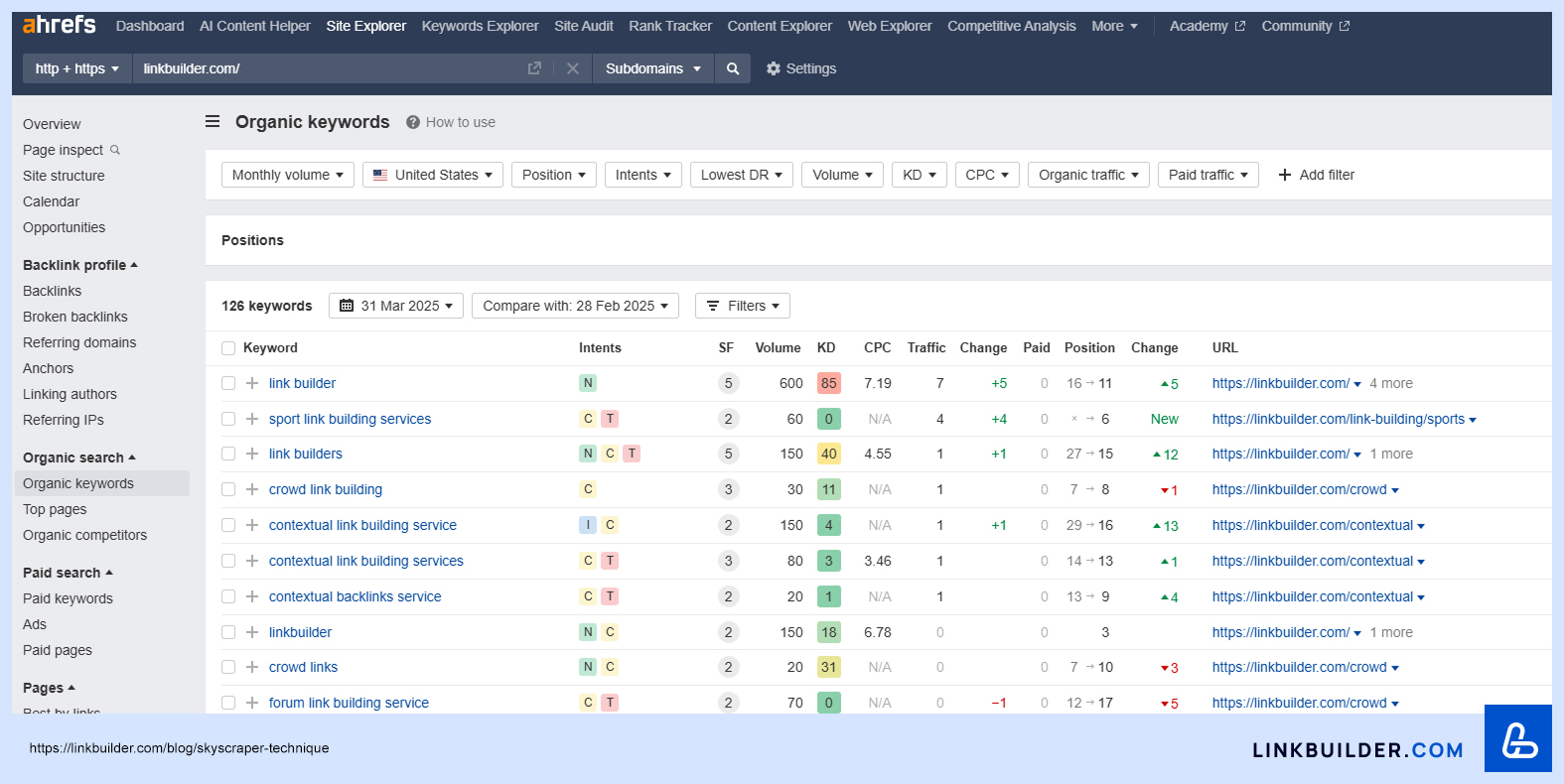
- Measure content engagement using Organic Traffic data.
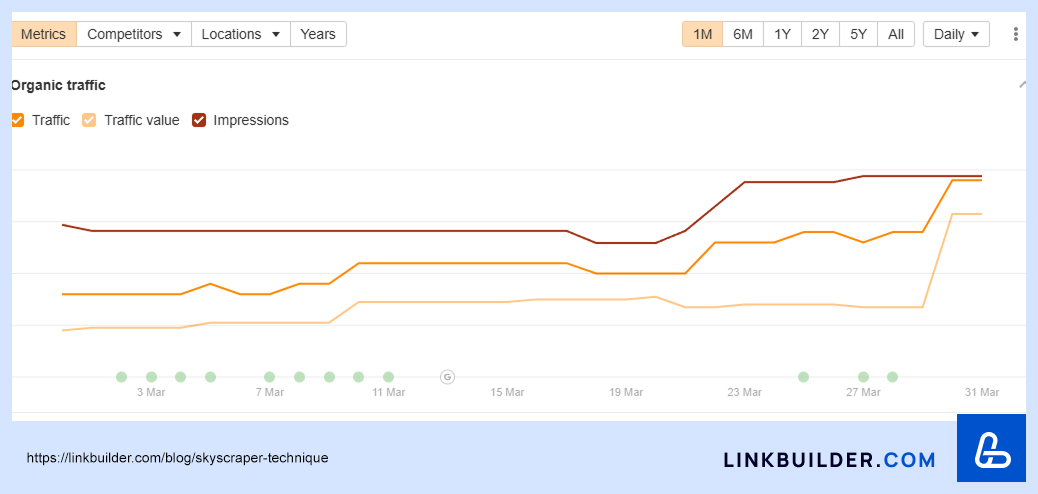
Semrush
Semrush is a one-stop competitor analysis toolbox offering insights into:
- Analyzing keyword trends with the Keyword Overview.

- Finding rising trends using Keyword Magic Tool + Trends.
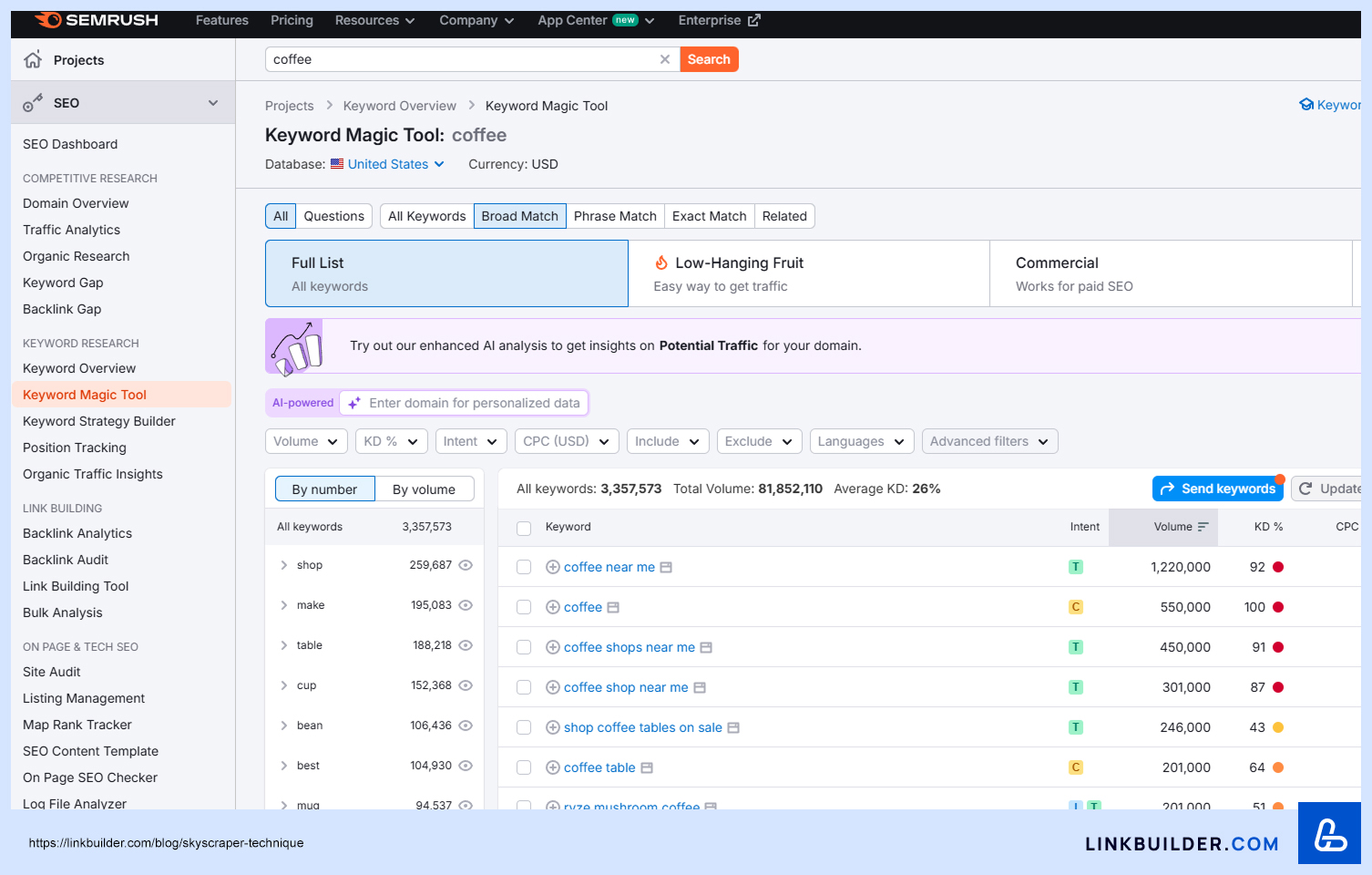
- Analyzing trends via Market Explorer (Niche/Competitor Trends).
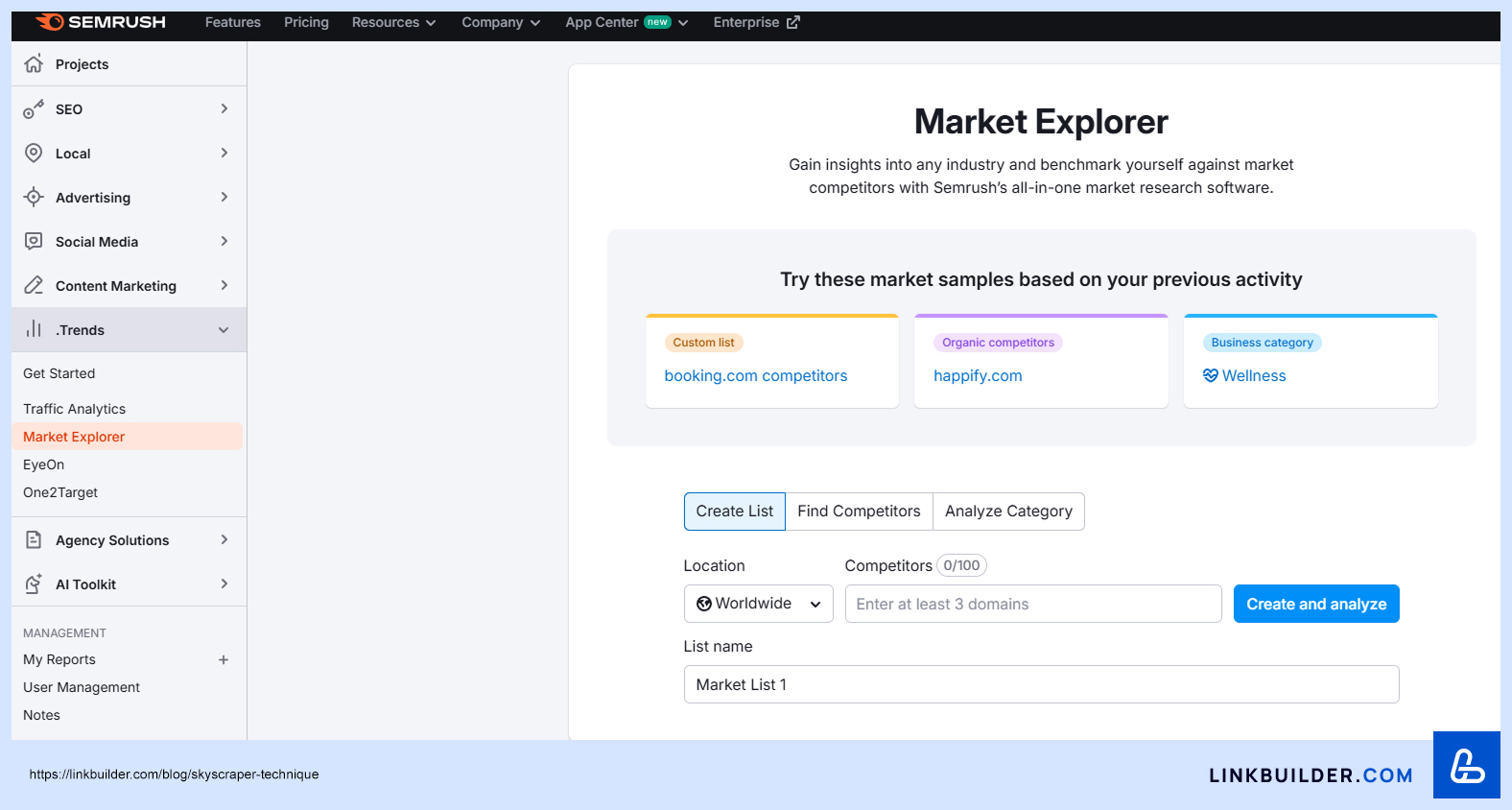
Moz
Moz is also a good tool for assessing domain authority and keyword difficulty.
- The Top Pages tool in Moz (part of Link Explorer) identifies a website’s most linked pages based on external backlinks.
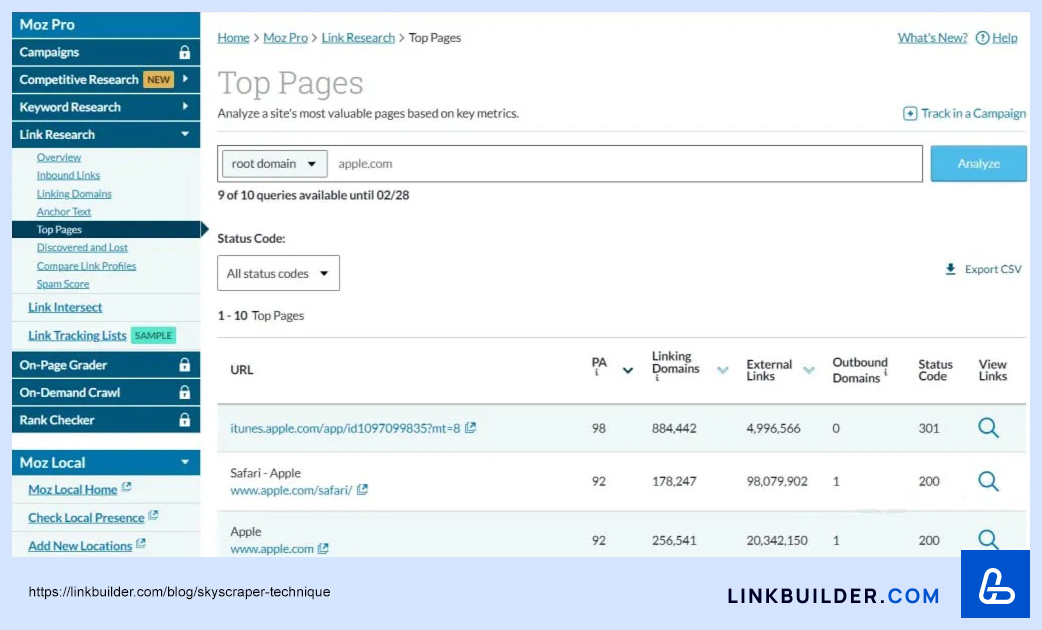
- Moz's Keyword Explorer is a tool for finding, analyzing, and selecting keywords for SEO. It provides data on search volume, keyword difficulty, and traffic potential.
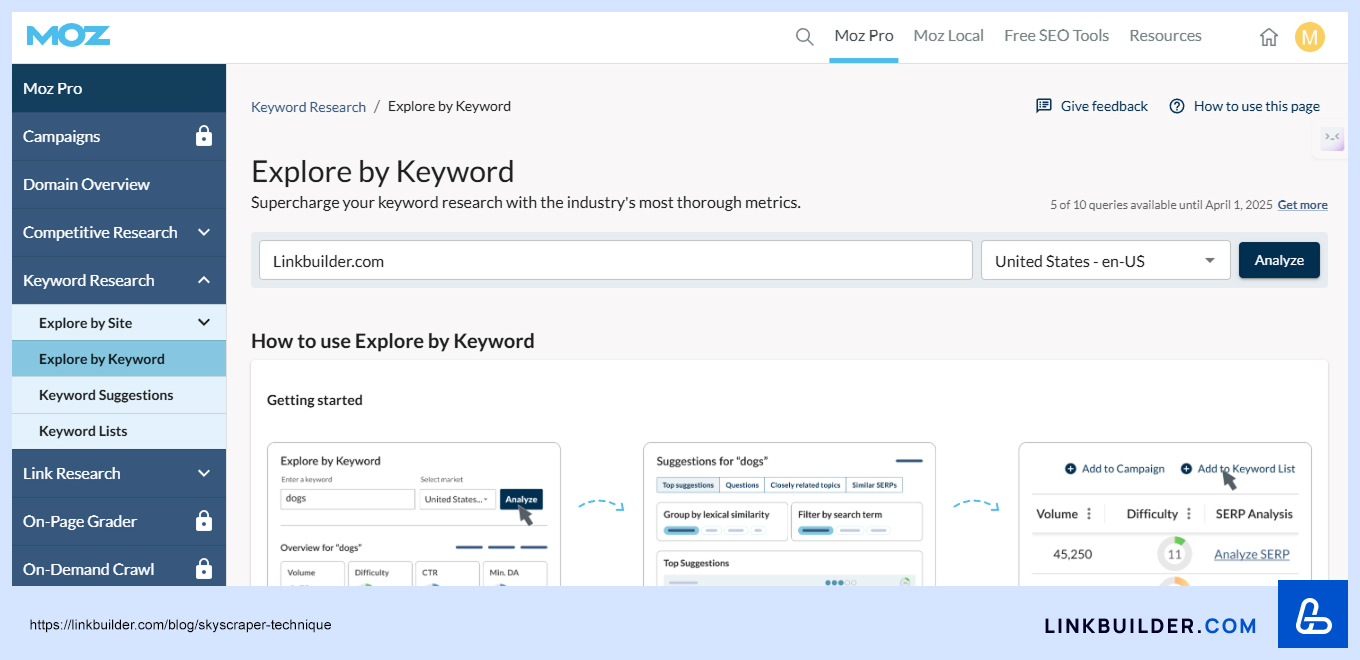
Using these tools, you can determine which content is worth competing against, what improvements you need to make, and how to position your content for maximum impact.
- Selecting Evergreen vs. Trending Topics for Maximum Impact
Once you’ve identified competitor content, the next step is choosing whether to focus on evergreen or trending topics. Each has its advantages, and the best strategy often involves a combination of both.
Evergreen Topics: Long-Term SEO Success
Evergreen content remains relevant over time, attracting traffic and backlinks long after publication. It is ideal for developing skyscraper content, as it provides long-term SEO benefits.
Examples of evergreen topics:
- “How to Optimize a Website for SEO”
- “Beginner’s Guide to Content Marketing”
- “Best Strategies for Link Building in 2026”
Benefits of evergreen content:
- Consistent traffic over time: Ranks well for months or years, bringing steady visitors.
- Long-term backlinks: Naturally attracts links as a trusted, go-to resource.
- Minimal updates required: Small tweaks can keep it fresh.
Trending Topics: Short-Term Traffic Boost
Trending content capitalizes on current events, industry changes, or viral topics. While it might generate spikes in traffic, it can quickly lose relevance as trends fade.
Examples of trending topics:
- “Google's Latest Algorithm Update and Its Implications for SEO”
- “SEO for TikTok: The Future of Blogging?”
- “Search Intent vs. Keyword Research”
Benefits of trending content:
✅ Rapid exposure & search demand: Taps into hot topics with high search interest.
✅ Viral potential on social media: More shareable content increases reach and engagement.
✅ Competitive edge in your niche: Covering trends early positions you as an industry leader.
So, what is the best strategy to achieve the maximum results?
- Prioritize evergreen content for stable, long-term SEO growth.
- Use trending topics to gain quick traction and establish topical authority.
- Combine both by updating evergreen content with relevant trends and industry updates.
Writing Skyscraper Content That Earns Links & Traffic

Remember, the skyscraper technique isn’t just about writing better content. It’s about creating something so valuable, engaging, and authoritative that it naturally attracts links, shares, and traffic.
To achieve this, you need to focus on two key aspects: structuring content for SEO & readability and incorporating data, infographics, and interactive elements that enhance its value.
- Structuring Content for SEO & Readability
Even the best content will struggle to perform if it’s difficult to read or poorly optimized for search engines. When writing skyscraper content, your goal is to make it easy to understand and process, search-friendly, and engaging for both users and search engines.
Here’s how to structure your content effectively:
1. Use a Clear & Logical Hierarchy
Search engines and readers prefer well-structured content. Use:
- H1 for the main title (only one per page).
- H2s for major sections to break content into clear parts.
- H3s and H4s for subtopics to improve scannability.
This structure facilitates user navigation and helps search engines comprehend your material.
2. Optimize for Featured Snippets
Featured snippets (position zero in Google) can drive massive traffic. To increase your chances:
- Use bullet points & numbered lists for quick answers.
- Include concise, well-formatted answers near the top of your article.
- Use keyword-rich subheadings that match search intent.
3. Keep Paragraphs & Sentences Short
Online readers skim content. Improve readability by:
- Using short paragraphs (2-3 sentences max).
- Breaking up text with whitespace.
- Writing in a conversational, active voice.
4. Internal & External Linking
Links add depth, improve credibility, and enhance SEO.
- Internal links guide visitors to relevant pages on your website.
- External links that point to reputable sites enhance SEO and demonstrate reliability.
5. Mobile Optimization
With Google’s mobile-first indexing, your content must be easy to read on smartphones:
- Use responsive design.
- Avoid large blocks of text.
- Ensure fast-loading pages for better Core Web Vitals scores.
Well-structured and SEO-friendly content improves rankings and keeps visitors engaged, leading to higher traffic and more backlinks.
- The Role of Data, Infographics & Interactive Elements
Adding data, visuals, and interactive components makes your skyscraper content more authoritative, shareable, and engaging, making it more effective for link building.
1. Data-Driven Insights Build Credibility
People trust content backed by real data. Use:
- Industry statistics from reputable sources.
- Case studies & original research to showcase expertise.
- Surveys & reports to present fresh insights.
Example: Instead of saying, “Long-form content ranks better,” cite a study:
📌 “According to Backlinko, pages with 1,890+ words rank higher on Google.”
Tip: When using external data, link to the original source. It will help you obtain valuable backlinks and build trust.
2. Infographics Increase Shareability
Infographics help simplify complex topics, making them more engaging and shareable.
Benefits of infographics:
- Easier to understand than long text blocks.
- More likely to be shared on social media.
- Can attract backlinks when others reference them.
Example: Instead of a prolonged (e.g., over 500-word) explanation of Google’s ranking factors, create a visual breakdown of the top factors influencing rankings.
3. Interactive Elements Enhance Engagement
By keeping visitors on the page longer, interactive content tells Google that your content is high-value.
Examples of interactive elements:
- Quizzes & polls (e.g., “Test Your SEO Knowledge”).
- Calculators & tools (e.g., a “Backlink Quality Checker”).
- Embedded videos & animations to explain key points.
Why this matters:
Google tracks engagement metrics (time on page, bounce rate) when ranking content. More interaction = better rankings.
Perfecting the Outreach Strategy for Maximum Backlinks

The skyscraper method is only as effective as your ability to secure backlinks. You can create the most comprehensive, best-optimized content, but without quality outreach, it won't get the attention it deserves.
Backlink outreach is both an art and a science, requiring the right mix of psychology, personalization, and strategic email templates to maximize response rates and land high-quality links. Here's how to perfect your approach in 2026.
- The Psychology of Outreach: How to Get a High Response Rate
Before you start sending outreach emails, you need to understand what makes people say "yes" to linking back to your content.
Most website owners and editors receive a flood of link requests. You must appeal to their interests, priorities, and emotions to stand out from the noise.
1. Offer Value First
No one wants to do you a favor for free. Instead of asking for a link upfront, show what benefits your content can bring:
- Fix broken links on their site with your relevant resource.
- Provide updated data that strengthens their existing article.
- Offer unique insights or expert quotes to enhance their content.
2. Make It About Them, Not You
A common mistake in outreach emails is focusing too much on your needs rather than the recipient's. Instead of saying:
🚫 "I created an amazing guide. Can you link to it?"
Say:
✅ "I noticed your post on [Topic] has a section on [Specific Point]. My article expands on this with updated research and fresh insights your audience might find valuable."
3. Use Social Proof & Authority Signals
People are more likely to link to content that others trust. If possible, include:
- Mentions of other high-authority sites that have linked to your content.
- Social media engagement metrics to show content popularity.
- Notable guest posts or collaborations that establish credibility.
4. The Power of Reciprocity
When you give first, people feel naturally inclined to return the favor. Before reaching out, try to:
- Engage with their content (e.g., commenting, sharing, linking).
- Feature them in your article (e.g., quoting their expertise).
- Offer a mutual collaboration (e.g., guest posts, co-marketing).
- Personalization & Relationship Building vs. Mass Emailing
Personalized emails generate high-quality backlinks, but mass email outreach is a numbers game. The days of copy-paste generic templates are over. These days, website owners can quickly identify them.
Why personalization wins:
- Higher response rates because people feel valued.
- Increased trust and credibility.
- Better long-term relationships, leading to future collaboration.
Key personalization techniques:
- Use their name: Avoid "Dear Website Owner" or "Hi Admin."
- Mention a specific piece of their content: Show you've actually read their work.
- Reference a shared interest or mutual connection: It will help the email appear natural.
- Customize your CTA (Call to Action): Instead of "Can you link to my post?" try "Would love to hear your thoughts, think this could add value?"
When (If Ever) Does Mass Emailing Work?
Mass outreach can work when:
- You segment your outreach lists carefully (targeting only highly relevant sites).
- Your email still has a degree of personalization (like auto-inserting site names).
- Your content is genuinely exceptional (e.g., original research, viral case studies).
However, adding some human touch will drastically improve success rates even in bulk outreach.
Common Mistakes That Kill the Skyscraper Technique And How to Fix Them

Now, we all know what the skyscraper technique is. However, despite its potential, many digital marketers and link builders encounter pitfalls that hinder their success. Let's break down some common mistakes that can affect your results.
1. Relying Only on Length Instead of Quality
The idea that "the more, the better" has led many content creators to believe that simply increasing word count will improve their SEO results.
While length can be a factor in rankings, mindlessly adding more words without enhancing content quality can have the opposite effect. Google and readers alike prioritize value over verbosity.
Why "Longer" Doesn't Always Mean "Better"
- Google Prioritizes Search Intent, Not Word Count
Google's algorithm has shifted its focus to user intent. If the user needs a quick answer, a 5,000-word article full of unnecessary details won't help. Besides, it can lead to a higher bounce rate as users leave the page frustrated.
- Readers Lose Interest in Fluff-Filled Content
User engagement metrics significantly influence rankings, including dwell time, bounce rate, and scroll depth. When readers scan through your content and quickly jump away, Google takes it as a negative signal.
Factors that turn users away:
❌ Unnecessary storytelling: Personal anecdotes can add value, but too much can distract from the main point.
❌ Over-explaining simple concepts: Readers may already know the basics, so avoid treating them like beginners unless necessary.
❌ Repetitive phrasing: Saying the same thing in different ways makes the content feel bloated.
- SEO Tools Now Analyze Content Quality, Not Just Length
Modern SEO tools like Surfer SEO, Clearscope, and Frase don't just look at word count. They assess content relevance and topic coverage.
Example: A detailed, well-structured article with strong visuals and expert insights can rank higher than a text-heavy post that simply repeats existing information.
How to Enhance Content Depth Without Fluff
1. Focus on Answering the Reader's Main Questions
Before writing, ask:
What does the reader actually want to know?
What gaps exist in current top-ranking content?
Can I provide unique insights, case studies, or expert opinions?
Use tools like AnswerThePublic or People Also Ask (on Google SERPs) to find real user queries.
2. Use Data, Expert Insights & Real-World Examples
Instead of repeating generic advice, make your content stand out with:
- Case studies: Show real-world applications of your points.
- Data-driven insights: Cite industry reports or conduct your own research.
- Expert opinions: Interview professionals in your field.
3. Improve Readability & Structure
Dense, unstructured content feels overwhelming. Make it scannable with the following:
- Bullet points & numbered lists: Break down information for easy reading.
- Short paragraphs (2-3 sentences max): Large text blocks can feel intimidating.
- Descriptive subheadings: Help readers navigate and find relevant sections quickly.
- Visual aids (infographics, tables, videos): Enhance understanding and retention.
4. Cut Unnecessary Filler
Review your content and ask: Does every sentence add value? If not, remove it.
Instead of: "As we all know, SEO is vital for online success, and without it, websites wouldn't be able to gain any traction."
Write: "SEO is essential for online visibility."
Concise writing keeps users engaged and improves comprehension.
5. Balance Long-Form & Short-Form Content
Not every topic needs a 5,000-word guide. Some queries can be fully answered in 1,200 words.
The key is to match content length to search intent.
Example:
- Short-form (1,000-1,500 words): FAQ-style answers, product reviews, quick guides.
- Long-form (2,500+ words): Ultimate guides, research studies, deep-dive analysis.
2. Choosing the Wrong Content to Outperform
One of the most critical steps in executing the skyscraper technique is selecting the right content to improve upon.
Many creators make the mistake of targeting content that is either too competitive, irrelevant, or lacks backlink potential. Even the best-written article won't generate the desired SEO results without careful selection.
Here's how to pick the best content to outperform:
- Look for Content with Strong Backlink Profiles
What is the primary goal of the skyscraper content? It is to replicate and improve a competitor's backlink strategy. The best content to target is one that:
- Ranks in the top 10 for a valuable keyword
- Has attracted high-quality backlinks from authoritative sources
- Still has room for improvement (outdated, poorly structured, or lacking depth)
Example: If an article on "Best SEO Strategies for 2026" has 300+ backlinks but lacks updated AI-driven insights, it's an excellent option for improvement.
- Identify Weaknesses in Existing Top Content
Just because a page ranks high doesn't mean it's perfect. Look for gaps you can exploit to create a better version.
Key weaknesses to look for:
- Outdated statistics or sources
- Lack of real-world examples or case studies
- Poor readability or user experience
- No engaging visuals, data charts, or infographics
How to spot weaknesses:
- Read user comments on the page. What complaints do readers have?
- Check the last update date. Is the content old?
- Use Google's Natural Language API to analyze content readability.
Once you've identified potential content to outperform, the next step is analyzing its strengths and weaknesses. AI and SEO tools can help you break down what makes a competitor's page successful and how to improve upon it.
Use AI to Analyze Content Quality & Gaps
Modern AI-driven tools provide deep insights into competitor content quality.
Three Top AI-Powered SEO Tools:
- Surfer SEO: This tool analyzes keyword usage, structure, and readability.
- Frase.io: AI compares competitor content to show missing topics.
- Clearscope: This one uses NLP to determine content relevance for target queries.
Action Step:
- Copy and paste a competitor's article into Frase.io to see what topics they cover and what they miss.
- Use Surfer SEO to compare word count, headings, and keyword density.
Check Competitor Backlink Profiles
A skyscraper blog article only works if webmasters are willing to replace their backlinks.
Best Backlink Analysis Tools:
- Ahrefs' Backlink Checker: It helps identify who links to your competitor's content.
- Moz's Link Intersect: This tool will show you common backlinks between competitors.
- Semrush Backlink Gap: It finds link opportunities you're missing.
Action Step:
- Identify high-authority websites linking to a competitor.
- Reach out with your improved content and request a link replacement.
Compare Readability & UX Metrics
Google rewards user-friendly content. If a top-ranking page has poor readability, you have a competitive advantage.
Top UX & Readability Tools:
- Hemingway Editor: It highlights difficult-to-read sentences.
- Google PageSpeed Insights: This tool checks loading speed, a critical ranking factor.
- Hotjar: This platform shows how users interact with competitor pages.
Action Step: If a competitor's article has dense paragraphs and no visuals, make your version easier to scan with bullet points and images.
3. Ignoring Proper Outreach & Link-Building
No matter how well-written and valuable your skyscraper content is, it won't generate backlinks if your outreach strategy is weak.
Many marketers focus entirely on content creation and ignore the crucial step of link-building, which is what makes the technique work in the first place.
Even the most comprehensive, engaging, and well-researched content can sit unnoticed without a solid outreach plan.
Why Many Skyscraper Campaigns Fail at the Outreach Stage
The biggest mistake of this method is assuming that great content automatically attracts links. The reality? Outreach is just as important as the content itself.
Here's why many campaigns fail:
1. Mass Emailing Without Personalization
Sending out generic outreach emails rarely works. Blog owners and site editors receive hundreds of link requests daily, so why should they care about yours?
❌ Mistake: Sending the same copy-paste email to every contact.
✅ Fix: Personalize each email by mentioning their website, content, and why your article is valuable.
2. Targeting the Wrong People
Not everyone who linked to a competitor will replace their backlink. Some websites don't update old links, while others only link to trusted sources.
❌ Mistake: Contacting low-authority or irrelevant sites.
✅ Fix: Prioritize outreach to authoritative sites with a history of linking to updated resources.
3. Weak or Unclear Value Proposition
If your outreach email doesn't explain why your content is better, website owners won't bother.
❌ Mistake: Saying, "I wrote a better article. Please link to it."
✅ Fix: Highlight specific improvements. Use more research, updated stats, better readability, expert insights, or multimedia elements.
4. Focusing on Keyword Stuffing Instead of Reader Experience
For years, the maximum-injection-of-keywords strategy was the mantra of many SEO professionals. Today, however, Google cares more for the user experience (UX) than the mere density of a keyword. An engaging, well-structured, and valuable page will always outperform content that simply repeats keywords.
Hence, the Google ranking algorithm has evolved to consider users' interactions with the content instead of pure keyword stuffing. Some of the most crucial UX factors affecting rankings are:
Dwell Time & Bounce Rate
- Dwell Time: The longer a user stays on a page, the more valuable Google assumes the content is.
- Bounce Rate: If users leave quickly, it signals that the page didn't meet their expectations.
What this means for SEO: Content should be engaging, easy to read, and provide immediate value to keep users on the page.
Core Web Vitals & Page Speed
Google measures how fast and smoothly a page loads. Slow pages frustrate users, increasing bounce rates.
What this means for SEO: Optimize page speed by compressing images, reducing unnecessary code, and using a fast hosting provider.
Mobile Friendliness
Mobile devices contribute over 60% of all searches. If a site isn't mobile-friendly, Google will reduce its rankings.
What this means for SEO: Ensure content is responsive, with readable fonts and well-spaced paragraphs for smaller screens.
Content Relevance & Readability
Google's AI evaluates whether content efficiently answers a searcher's question. If an article is cluttered, repetitive, or difficult to read, it won't rank well.
What this means for SEO: Focus on clarity, logical structure, and delivering value quickly.
Resources for Skyscraper Success in 2026

The following platforms can help you boost your SEO results and build high-quality backlinks at scale so that you can make the most of your skyscraper content in 2026.
Outreach & Link-Building Automation:
Even the best content won’t rank without backlinks. The outreach phase of the skyscraper technique is where many fail. These tools help automate outreach and improve success rates:
LinkBuilder.com: Perfect for those who already have content but need high-quality backlinks. If a client wants to obtain links, they can either:
- Contact a dedicated manager who will assist them by handling the tedious tasks of getting links.
- Use the Guest Post Project via https://app.linkbuilder.com to explore a vast database of websites selling guest post placements. This tool helps you compare prices on different marketplaces, select the most cost-effective options, and purchase backlinks with complete transparency.
- Check out our new free Sponsored Content Website Audit tool, available without registration on the website. This tool lets users quickly analyze whether a specific site sells backlinks, making it simpler to vet potential links before deciding.
Pitchbox: Automates email outreach, finds high-quality prospects, and tracks response rates.
BuzzStream: A relationship-focused outreach tool that helps manage contacts, track emails, and personalize messages.
Respona: Uses AI-powered automation to create highly personalized outreach campaigns for Skyscraper content promotion.
Content Distribution & Promotion:
Once your skyscraper content is live, you should drive traffic and amplify its reach. The following platforms and tools help distribute content to a broader audience:
- LinkedIn Pulse: Perfect for repurposing long-form content and increasing B2B engagement.
- Medium: Helps reach a broader readership while building brand authority.
- Growth-Hacking Tools: Platforms like Quuu, Viral Content Bee, and Missinglettr automate content promotion across social media and niche communities.
Is the Skyscraper Technique Worth It in 2026?
While the skyscraper technique seems timeless, the answer isn't a clear-cut yes or no.
On the one hand, the skyscraper method continues to be effective for building high-quality backlinks. The foundation of SEO success is still high-quality content, and enhancing already-existing material can make your website stand out in a crowded digital market.
However, as search engines become more advanced and user intent becomes the focal point, relying solely on this method can feel limiting. It no longer guarantees long-term, sustainable results without the addition of other strategies, like topical authority or content optimization.
Link building in 2026 will be indeed more at one holistic view, integrating the skyscraper approach with other evolving tactics. If you're looking for a streamlined, efficient way to improve your backlink profile, platforms like LinkBuilder.com are helping businesses secure high-quality links without the guesswork. With its cutting-edge tools and resources, LinkBuilder.com helps companies integrate the latest SEO practices, ensuring that they stay ahead of the competition in 2026.








